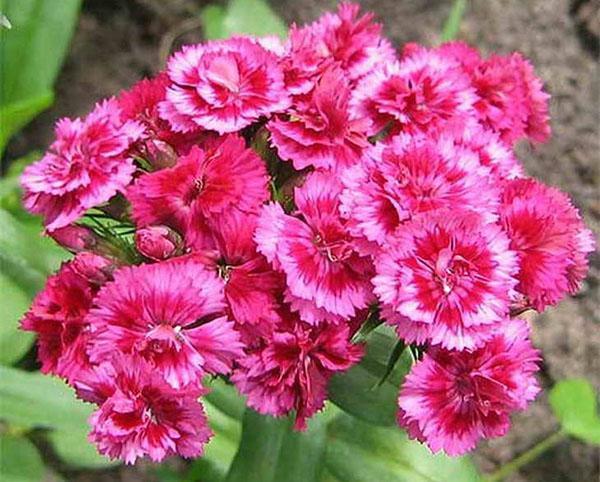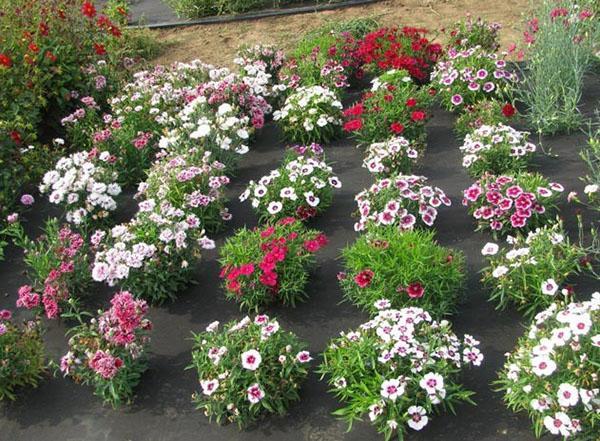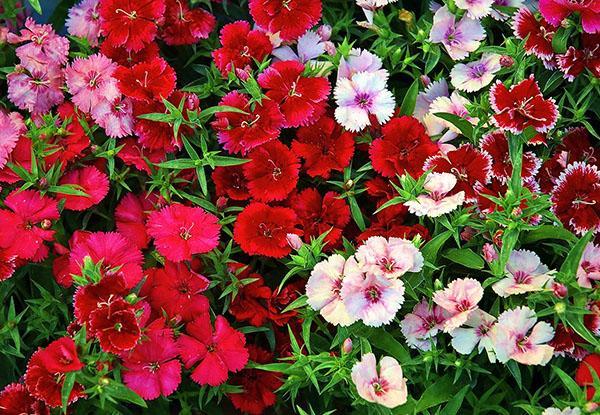Growing a Chinese carnation for a stylish garden decoration
 There are a huge number of plants to create an original landscape. But growing Chinese carnations is truly worthwhile. Its lush and colorful buds have been decorating the garden plots of our compatriots for a long time. When it begins to bloom, the garden turns into an oasis of pleasure where you can enjoy your time. What does a Chinese carnation look like and what is the secret of growing it? Let's try to find answers to these important questions.
There are a huge number of plants to create an original landscape. But growing Chinese carnations is truly worthwhile. Its lush and colorful buds have been decorating the garden plots of our compatriots for a long time. When it begins to bloom, the garden turns into an oasis of pleasure where you can enjoy your time. What does a Chinese carnation look like and what is the secret of growing it? Let's try to find answers to these important questions.
Colorful mosaics at our feet


During the flowering period, the bushes "light up" with a bright mosaic of many shades:
- red;
- snow-white;
- pink;
- purple;
- purple;
- burgundy;
- scarlet.
Growing a Chinese carnation is a very enjoyable experience as it allows you to use different varieties of the plant. Some of them are two-tone. Others are speckled. There are striped specimens and even with ornate "eyes". The structure of the buds is double, simple and semi-double. Depending on the species, the inflorescence has up to about 20 petals with fine serrations or exquisite fringes.
In mid-latitudes, the plant blooms for 2.5 months. The first buds bloom in June, and the last ones - 2 weeks before the end of summer.
Growing Chinese carnations: basic rules
 Even an inexperienced gardener can decorate a summer cottage with exotic flowers. Some varieties are capable of self-propagation. In the cold season, the seeds pass naturally stratification, and when the soil warms up, germinate. As a result, a mosaic of bright colors appears on the flower bed.
Even an inexperienced gardener can decorate a summer cottage with exotic flowers. Some varieties are capable of self-propagation. In the cold season, the seeds pass naturally stratification, and when the soil warms up, germinate. As a result, a mosaic of bright colors appears on the flower bed.
To grow an annual carnation from seeds, several conditions must be met. First of all, it is important to choose the right time for planting a plant in open ground. This is usually done in early May, when the soil warms up slightly. The main thing is that there are no frosts at night, otherwise the carnation may suffer.
To protect the plant, it is advisable to build a shelter made of plastic wrap.
Before planting a Chinese clove, the seeds are soaked in a special liquid (succinic acid) for about 20 minutes. Then they are slightly dried at a temperature of 18 ° C, after which they are sown.
Soil preparation includes:
- clearing the site from weeds;
- loosening the earth;
- leveling the ground surface;
- marking the territory with shallow grooves.
The planting material is spread at a distance of 5 mm from each other. Otherwise, the shoots will be very thin and weak. The optimum temperature for growing Chinese carnations from seeds is about + 20 ° C during the day. At night, not lower than 15 ° C. After 21 days, the first greens will appear. If the crops are thick, it is enough to thin them out.
An adult plant looks great:
- on the background lawn grass;
- instead of borders on garden alleys;
- in flower arrangements;
- on the alpine slides.
Since winter in mid-latitudes is usually prolonged, it is better to grow Chinese carnations using seedlings. Practice shows that this method is much cheaper and safer. What steps are required to make an original carpet of bright colors appear in the country? Let's analyze all the actions step by step.
Seedlings and a gorgeous flower garden
 As people enjoy the magnificent flower beds in city parks, they realize that there is a tremendous amount of work behind it. Bright flowers require special attention. Therefore, business must be approached with wisdom. First, the containers are filled with fertile soil. Then in late February or early March, the plant is sown.
As people enjoy the magnificent flower beds in city parks, they realize that there is a tremendous amount of work behind it. Bright flowers require special attention. Therefore, business must be approached with wisdom. First, the containers are filled with fertile soil. Then in late February or early March, the plant is sown.
To increase the flowering period, planting material is lowered into the soil in April.
Covering the seeds with a thin layer of soil, watered with a spray bottle. The containers are placed in a well-lit area. To accelerate the growth of flowers, watered regularly. When the seedlings are hardened, they are transplanted into other pots. To stimulate the development of side shoots, you need to know how to pinch a Chinese carnation. Gardeners advise doing the procedure very carefully. To do this, you need to cut off the top of the plant, leaving 2 or 3 pairs of leaves on the shoot. Over time, the plant will develop into an exquisite bush covered with miniature buds.
 In the last decade of April, Chinese cloves are periodically taken out to fresh air for hardening. Thanks to this procedure, she will get used to the new conditions and will be less sick after disembarkation. A flower is planted in a flower bed after May 15, focusing on weather conditions.
In the last decade of April, Chinese cloves are periodically taken out to fresh air for hardening. Thanks to this procedure, she will get used to the new conditions and will be less sick after disembarkation. A flower is planted in a flower bed after May 15, focusing on weather conditions.
It is advisable to place the bushes at a distance of about 30 cm from each other.
Decent care for luxurious flowers

Perennial Chinese carnation is a frequent exotic guest on the territory of country houses. It is not at all difficult to grow it, and the flower takes root on any kind of soil. The plant is used in the formation of mixborders, flower beds and flower beds.
Thanks to the painstaking work of breeders, there are many different varieties of Chinese carnations:
- "Diamond";
- Vesuvius;
- "Diana";
- "Tenderness".
Having met only a few, it is easy to notice the distinctive features of the plant, which are manifested in the height of the bush, the shape of the bud and the coloring of the petals. Recently, summer residents have come to love the Chinese terry carnation mix, which does not require special care.
It is enough to follow the basic rules:
- even moisturizing;
- regular loosening of the soil;
- feeding the flower with complex fertilizers (at least 3 times per season);
- cutting of wilting inflorescences;
- removal of greenery for the winter (leave shoots 10 cm high);
- construction of a shelter in severe frosts.
 In addition, when choosing a place for planting a carnation, it is important to take into account its need for sunlight. A partial shade or open area is best.
In addition, when choosing a place for planting a carnation, it is important to take into account its need for sunlight. A partial shade or open area is best.
Preventing Chinese Clove Disease

However, in some cases, the plant begins to hurt for the following reasons:
- dense plantings in a flower bed;
- an abundance of moisture;
- lack of calcium in the soil;
- excess nitrogen;
- the use of a large amount of fertilizers.
Even the neighborhood with other flowers sometimes leads to the appearance of yellow foliage and weak shoots. Tulips, for example, infect Chinese carnations with a fungus. And if you grow a flower in one flower bed for over 5 years, it loses its attractiveness. When such specimens appear, they must be immediately removed away from healthy flowers.
Reproduction of Chinese carnation

Perennial Chinese carnations are propagated in three ways:
- grafting;

- dividing the bush;
- sowing seeds.

For the first method, shoots are used that do not have buds, but there are leaf nodes (at least 4). Cut off the stalk, departing from the lower nodes about 1 cm. Then make a small incision, tear off the foliage, then place it in the sand and cover with polyethylene. The root system is formed in 21 days.
 By dividing the bush, the bushes of those types of carnations that have a powerful root are propagated.The procedure is carried out in the spring, when the soil warms up well. First, the bushes are dug up, then they are divided into parts. The resulting specimens are placed in the holes, covered with earth and moistened. By the middle of summer, the plant takes root and pleases the eye with lush greenery.
By dividing the bush, the bushes of those types of carnations that have a powerful root are propagated.The procedure is carried out in the spring, when the soil warms up well. First, the bushes are dug up, then they are divided into parts. The resulting specimens are placed in the holes, covered with earth and moistened. By the middle of summer, the plant takes root and pleases the eye with lush greenery.
An amazing flower - the Chinese carnation can be the highlight of any garden plot. After all, its cultivation does not require special skills. It is enough to follow a few simple rules and the result will not be long in coming. Let the gardens of our compatriots resemble the paradise of delights described in the book of human history.